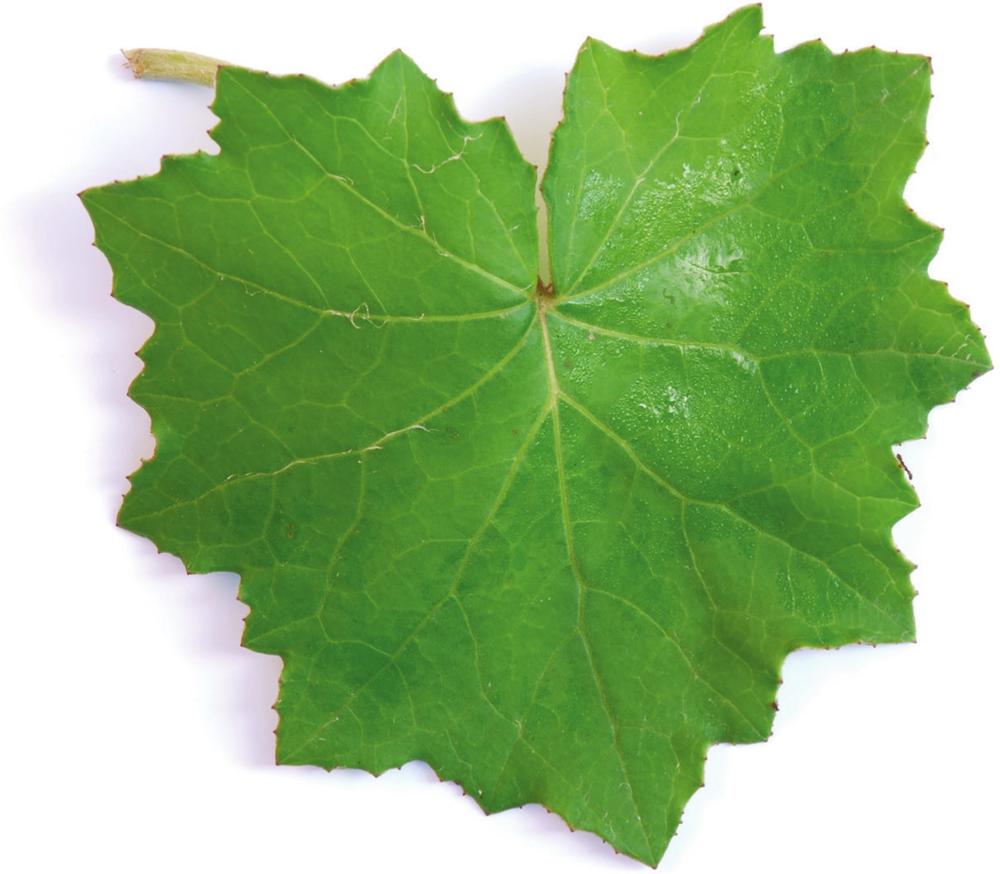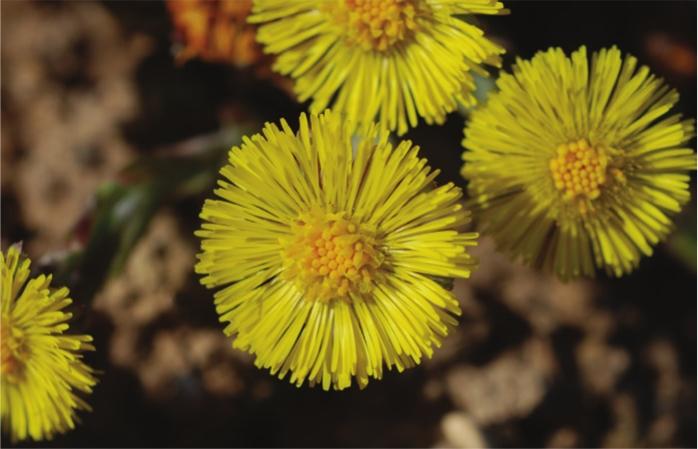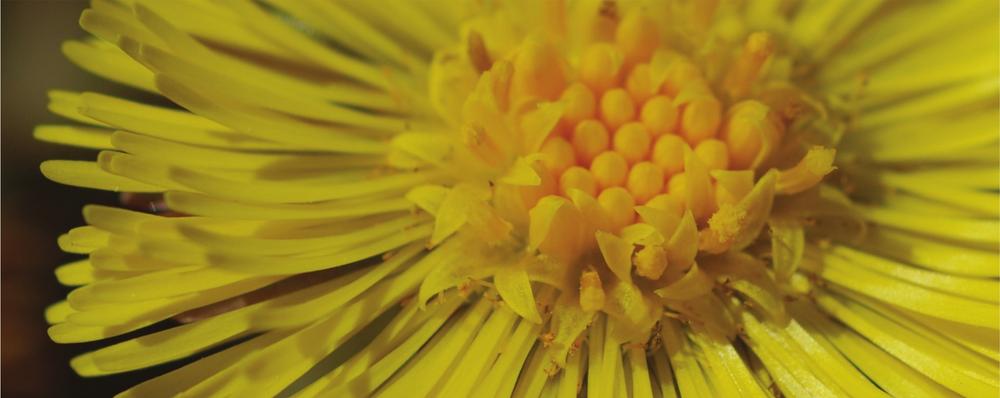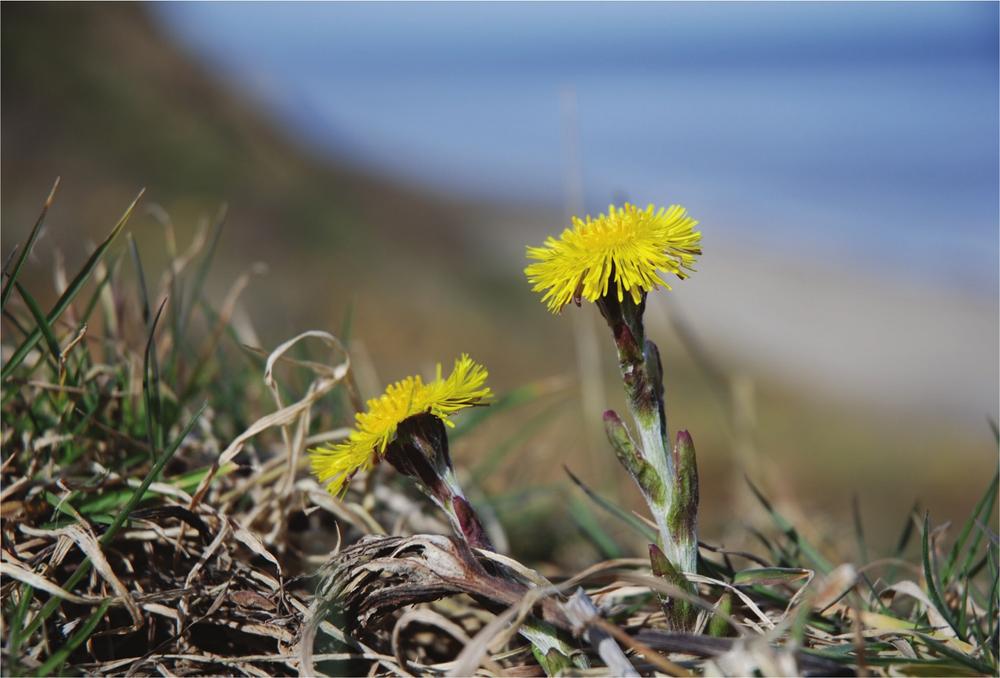Coltsfoot is one of the earliest plants of the herbalist’s year, and its leaves and flowers make an effective cough remedy.

Asteraceae (Compositae) Daisy family
Description: A perennial herb that flowers in late winter/early spring before the heart-shaped polygonal leaves appear.
Habitat: Stream banks, roadsides, cliffs, woodland and waste ground.
Distribution: Found throughout the British Isles, coltsfoot is native to Europe and northern Asia, and naturalised in North America.
Related species: In summer, the leaves of coltsfoot can be mistaken for butterbur (Petasites hybridus) and winter heliotrope (P. fragrans), which should not be used.
Parts used: Flowers harvested in early spring, leaves gathered in summer.
Coltsfoot is a common plant of roadsides, hedgerows and stream banks and is one of the first plants to flower in early spring. It produces flowers before leaves, a fact reflected in the old name ‘son before the father’. Coltsfoot is unmistakable when in flower, but its large, roughly heart-shaped leaves can be confused with the related butterbur in summer, so be sure you have the right plant.
It is the leaves that give coltsfoot its name. As well as colts or foals, they have also been named for the hooves of bulls, pigs and even asses. The flowers are succeeded by dandelion-like clocks made up of tiny white seed parachutes.
A bright sunny March morning saw us by the sea in north-eastern Norfolk, where the clay cliffs were maritime mini-meadows of sunny yellow. Here coltsfoot is a dominant plant, a coloniser and stabiliser of a crumbling, eroding coastline. An inspiring sight to eyes bereft of colour and sunlight through a long winter! The bees and hover flies were gorging on the sweet nectar, and seeing these swathes of sunshine you could finally believe spring was really back again.

Both flowers and leaves are used medicinally, and the Latin names tell us so. Tussilago is from the Latin tussis for cough, and farfara or flour refers to the whitish, cottony down on the underside of the leaves. Before commercial matches were available, this down was collected and dipped into a solution of saltpetre for use in tinder-boxes.

Use coltsfoot for …
Coltsfoot has long been used for all kinds of cough and upper respiratory tract complaints. The flowers and leaves yield a sweetish, aniseedish tea, taken together or separately, fresh or dried. Some herbalists advise straining the tea to remove the leaf hairs, which can be an irritant.
It was an interesting coincidence for us that at the time we photographed the coltsfoot meadows Julie was suffering a hacking cough, so we gathered some flowers to make tea, which was just what she needed. It is very soothing, calming a cough almost at once. It helps moisten a dry irritating cough and loosen phlegm.
Coltsfoot leaves have also been used as a smoking tobacco since classical Greek and Roman times (respectively, Dioscorides and Pliny write about it), and have earned the name ‘British tobacco’. You can use the dried leaves to roll your own or smoke them in a pipe – proving that you can sometimes smoke to alleviate a cough!
Coltsfoot rock is an old-fashioned and pleasant-tasting commercially available confection. This is a good way to persuade children to take a cough remedy. And coltsfoot was usually the first wild flower available to make a light wine, appearing even before cowslip.
Coltsfoot has been found to contain pyrrolizidine alkaloids, as does comfrey. Not all these alkaloids are toxic, however, and coltsfoot’s small amounts do not appear to be harmful at low doses. As cough remedies are not normally taken long-term anyway, there is little chance of coltsfoot causing any problems. To be safe, we suggest taking it for no more than six weeks in total in a year.
Coltsfoot combines well with mullein, especially for dry coughs, and is good as a tea with fennel.
Coltsfoot and fennel tea
While coltsfoot can be used on its own as a tea, it is tastier and even more soothing when combined with fennel. You can use it fresh or dried to make this tea. To dry coltsfoot, spread the flowers or leaves on a screen or a tray and put it in an airing cupboard until they are crisp. Store in brown paper bags, or in a jar in a cool dark cupboard.
Put four or five coltsfoot flowers or a couple of leaves in a teapot with a heaped teaspoonful of fennel seed. Pour boiling water over them and brew for 10 minutes, then strain and drink hot.
Dose: Drink a cupful three times a day. It is wonderfully soothing for coughs and bronchial inflammation.
Coltsfoot and honey poultice
Mix the chopped leaves with enough honey to make a paste, and apply to boils and sores that won’t heal. Place a piece of gauze over the poultice, and bandage in place. Change for a fresh poultice every day until healed.

Coltsfoot